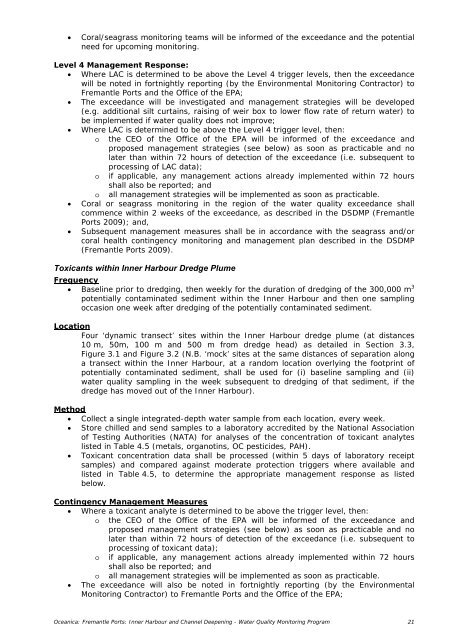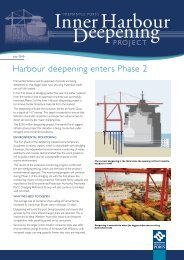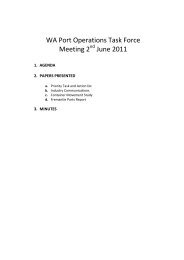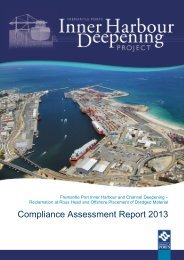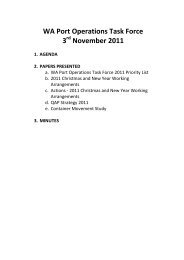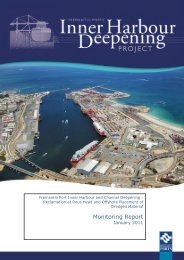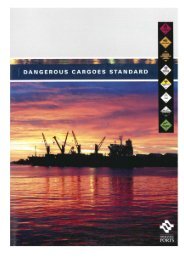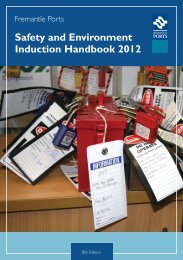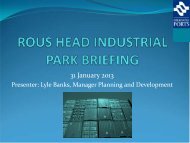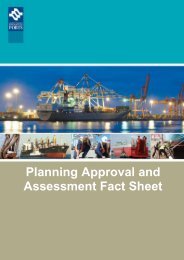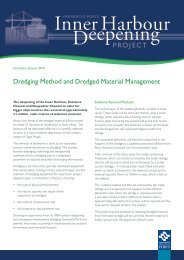Fremantle Port Inner Harbour and Channel ... - Fremantle Ports
Fremantle Port Inner Harbour and Channel ... - Fremantle Ports
Fremantle Port Inner Harbour and Channel ... - Fremantle Ports
Create successful ePaper yourself
Turn your PDF publications into a flip-book with our unique Google optimized e-Paper software.
• Coral/seagrass monitoring teams will be informed of the exceedance <strong>and</strong> the potential<br />
need for upcoming monitoring.<br />
Level 4 Management Response:<br />
• Where LAC is determined to be above the Level 4 trigger levels, then the exceedance<br />
will be noted in fortnightly reporting (by the Environmental Monitoring Contractor) to<br />
<strong>Fremantle</strong> <strong>Port</strong>s <strong>and</strong> the Office of the EPA;<br />
• The exceedance will be investigated <strong>and</strong> management strategies will be developed<br />
(e.g. additional silt curtains, raising of weir box to lower flow rate of return water) to<br />
be implemented if water quality does not improve;<br />
• Where LAC is determined to be above the Level 4 trigger level, then:<br />
o the CEO of the Office of the EPA will be informed of the exceedance <strong>and</strong><br />
proposed management strategies (see below) as soon as practicable <strong>and</strong> no<br />
later than within 72 hours of detection of the exceedance (i.e. subsequent to<br />
processing of LAC data);<br />
o if applicable, any management actions already implemented within 72 hours<br />
shall also be reported; <strong>and</strong><br />
o all management strategies will be implemented as soon as practicable.<br />
• Coral or seagrass monitoring in the region of the water quality exceedance shall<br />
commence within 2 weeks of the exceedance, as described in the DSDMP (<strong>Fremantle</strong><br />
<strong>Port</strong>s 2009); <strong>and</strong>,<br />
• Subsequent management measures shall be in accordance with the seagrass <strong>and</strong>/or<br />
coral health contingency monitoring <strong>and</strong> management plan described in the DSDMP<br />
(<strong>Fremantle</strong> <strong>Port</strong>s 2009).<br />
Toxicants within <strong>Inner</strong> <strong>Harbour</strong> Dredge Plume<br />
Frequency<br />
• Baseline prior to dredging, then weekly for the duration of dredging of the 300,000 m 3<br />
potentially contaminated sediment within the <strong>Inner</strong> <strong>Harbour</strong> <strong>and</strong> then one sampling<br />
occasion one week after dredging of the potentially contaminated sediment.<br />
Location<br />
Four ‘dynamic transect’ sites within the <strong>Inner</strong> <strong>Harbour</strong> dredge plume (at distances<br />
10 m, 50m, 100 m <strong>and</strong> 500 m from dredge head) as detailed in Section 3.3,<br />
Figure 3.1 <strong>and</strong> Figure 3.2 (N.B. ‘mock’ sites at the same distances of separation along<br />
a transect within the <strong>Inner</strong> <strong>Harbour</strong>, at a r<strong>and</strong>om location overlying the footprint of<br />
potentially contaminated sediment, shall be used for (i) baseline sampling <strong>and</strong> (ii)<br />
water quality sampling in the week subsequent to dredging of that sediment, if the<br />
dredge has moved out of the <strong>Inner</strong> <strong>Harbour</strong>).<br />
Method<br />
• Collect a single integrated-depth water sample from each location, every week.<br />
• Store chilled <strong>and</strong> send samples to a laboratory accredited by the National Association<br />
of Testing Authorities (NATA) for analyses of the concentration of toxicant analytes<br />
listed in Table 4.5 (metals, organotins, OC pesticides, PAH).<br />
• Toxicant concentration data shall be processed (within 5 days of laboratory receipt<br />
samples) <strong>and</strong> compared against moderate protection triggers where available <strong>and</strong><br />
listed in Table 4.5, to determine the appropriate management response as listed<br />
below.<br />
Contingency Management Measures<br />
• Where a toxicant analyte is determined to be above the trigger level, then:<br />
o the CEO of the Office of the EPA will be informed of the exceedance <strong>and</strong><br />
proposed management strategies (see below) as soon as practicable <strong>and</strong> no<br />
later than within 72 hours of detection of the exceedance (i.e. subsequent to<br />
processing of toxicant data);<br />
o if applicable, any management actions already implemented within 72 hours<br />
shall also be reported; <strong>and</strong><br />
o all management strategies will be implemented as soon as practicable.<br />
• The exceedance will also be noted in fortnightly reporting (by the Environmental<br />
Monitoring Contractor) to <strong>Fremantle</strong> <strong>Port</strong>s <strong>and</strong> the Office of the EPA;<br />
Oceanica: <strong>Fremantle</strong> <strong>Port</strong>s: <strong>Inner</strong> <strong>Harbour</strong> <strong>and</strong> <strong>Channel</strong> Deepening - Water Quality Monitoring Program 21


